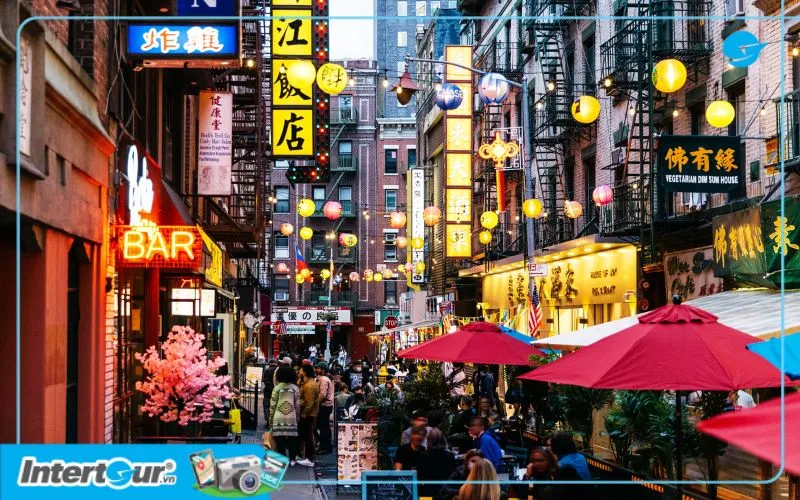When visiting New York, make sure to explore Chinatown, a vibrant and colorful “Little China” in the heart of Manhattan. This neighborhood is not just a district, but a living museum of Chinese culture, history, and cuisine, offering unique and unforgettable experiences. Let’s uncover what makes this Chinatown so special!
The History and Development of Chinatown in New York
New York’s Chinatown, located in Lower Manhattan, is one of the largest and oldest Chinatowns in the United States. Its history dates back to the mid-19th century, when the first Chinese immigrants arrived in New York seeking new opportunities. Initially, they settled around Mott Street, forming a small community.

As the immigrant population grew, the neighborhood expanded into surrounding areas such as Canal Street, Elizabeth Street, and Bayard Street. This growth was fueled by continuous waves of Chinese immigration, especially after the Chinese Exclusion Act of 1882 was repealed in 1943. Chinatown evolved into not only a residential area but a cultural and economic hub for the Chinese community in New York, offering everything from food and goods to healthcare and education.
Exploring Chinatown’s Unique Cultural Essence
Chinatown in New York is a vibrant display of Chinese culture, where tradition meets modernity. Walking through the bustling streets, you’ll encounter iconic images such as:
- Distinctive architecture: Houses with curved rooftops, streets adorned with red lanterns, and colorful murals create an unmistakably Asian ambiance.
- Language and signage: Mandarin and Cantonese resonate throughout the neighborhood. Storefront and restaurant signs are written in Chinese characters, adding to the cultural charm.
- Local customs: It’s common to see locals playing mahjong, practicing tai chi, or burning incense at temples.
A Culinary Paradise: Diverse and Delicious Food
New York’s Chinatown is a food lover’s paradise, offering an array of delightful dishes ranging from affordable street food to upscale restaurant fare. Here are some must-try recommendations:
- Dim Sum: Relish dim sum at renowned spots like Jing Fong or Nom Wah Tea Parlor. Dumplings, siu mai, steamed buns—each crafted meticulously with Cantonese flair.
- Xiao Long Bao: Savor juicy soup-filled dumplings with delicate skins and flavorful meat fillings. Joe’s Shanghai is famous for this iconic dish.
- Hand-Pulled Noodles: Watch skilled chefs perform the art of noodle-pulling and enjoy bowls of hot noodles in rich broth.
- Street Food Favorites: Sample street delicacies like sesame balls, bubble tea, skewers, and more to experience the variety of Chinese cuisine.
Shopping and Exploring Chinatown
Chinatown isn’t just about food; it’s a great place to shop and explore. From souvenirs and traditional clothing to herbal remedies and TCM (Traditional Chinese Medicine), there’s something for everyone.
- Canal Street Market: A bustling spot that sells everything from clothing and shoes to handbags and watches. Be cautious of counterfeit goods, though.
- Souvenir Shops: Pick up unique gifts like Buddha figurines, paper fans, or beaded bracelets to remember your visit.
- Traditional Medicine Stores: Learn about Chinese medicinal herbs and remedies and purchase products suited to your needs.
Top Sights to Visit in Chinatown
Beyond food and shopping, Chinatown boasts several noteworthy attractions:
- Confucius Statue: A 25-foot-tall statue of Confucius at the entrance of Chinatown, symbolizing Chinese philosophy and culture.
- Mahayana Temple: The oldest Buddhist temple in New York, showcasing traditional Chinese architecture.
- Museum of Chinese in America (MOCA): Discover the history and culture of Chinese Americans through exhibits that detail the struggles and achievements of this community.
Tips for Visiting Chinatown in New York
To make the most of your visit to Chinatown, keep these tips in mind:
- Time Your Visit: Allocate at least half a day to explore. Mornings or afternoons are ideal when the streets are less crowded.
- Transportation: Chinatown is centrally located in Manhattan, easily accessible by subway, bus, or taxi.
- Cash on Hand: Many small shops and restaurants only accept cash, so be prepared.
- Bargaining: Don’t hesitate to negotiate prices at markets, especially on Canal Street.
- Stay Safe: While Chinatown is generally safe, take care of your belongings and avoid deserted alleys late at night.
Conclusion
Exploring Chinatown in New York is an exciting journey into Chinese culture, cuisine, and history. This dynamic neighborhood is more than just a tourist destination—it’s a vital part of New York’s multicultural tapestry. If you’re planning a trip to New York, don’t miss the chance to visit Chinatown and immerse yourself in everything it has to offer.